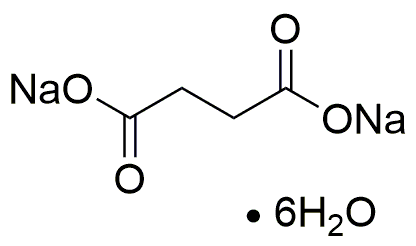Sodium succinate dibasic hexahydrate is widely utilized in research focused on:
- Pharmaceutical Formulations: It serves as a buffering agent in drug formulations, helping to maintain the pH levels necessary for drug stability and efficacy.
- Biotechnology: This compound is used in cell culture media to support the growth of various cell types, enhancing the yield of biopharmaceutical products.
- Food Industry: As a food additive, it acts as a flavor enhancer and stabilizer, improving the taste and shelf-life of processed foods.
- Agricultural Applications: It is utilized in fertilizers to provide essential nutrients to plants, promoting healthier growth and better crop yields.
- Cosmetic Products: The compound is incorporated into skincare formulations for its moisturizing properties, helping to improve skin hydration and texture.
General Information
Properties
Safety and Regulations
Applications
Sodium succinate dibasic hexahydrate is widely utilized in research focused on:
- Pharmaceutical Formulations: It serves as a buffering agent in drug formulations, helping to maintain the pH levels necessary for drug stability and efficacy.
- Biotechnology: This compound is used in cell culture media to support the growth of various cell types, enhancing the yield of biopharmaceutical products.
- Food Industry: As a food additive, it acts as a flavor enhancer and stabilizer, improving the taste and shelf-life of processed foods.
- Agricultural Applications: It is utilized in fertilizers to provide essential nutrients to plants, promoting healthier growth and better crop yields.
- Cosmetic Products: The compound is incorporated into skincare formulations for its moisturizing properties, helping to improve skin hydration and texture.
Documents
Safety Data Sheets (SDS)
The SDS provides comprehensive safety information on handling, storage, and disposal of the product.
Product Specification (PS)
The PS provides a comprehensive breakdown of the product’s properties, including chemical composition, physical state, purity, and storage requirements. It also details acceptable quality ranges and the product's intended applications.
Certificates of Analysis (COA)
Search for Certificates of Analysis (COA) by entering the products Lot Number. Lot and Batch Numbers can be found on a product’s label following the words ‘Lot’ or ‘Batch’.
*Catalog Number
*Lot Number
Certificates Of Origin (COO)
This COO confirms the country where the product was manufactured, and also details the materials and components used in it and whether it is derived from natural, synthetic, or other specific sources. This certificate may be required for customs, trade, and regulatory compliance.
*Catalog Number
*Lot Number
Safety Data Sheets (SDS)
The SDS provides comprehensive safety information on handling, storage, and disposal of the product.
DownloadProduct Specification (PS)
The PS provides a comprehensive breakdown of the product’s properties, including chemical composition, physical state, purity, and storage requirements. It also details acceptable quality ranges and the product's intended applications.
DownloadCertificates of Analysis (COA)
Search for Certificates of Analysis (COA) by entering the products Lot Number. Lot and Batch Numbers can be found on a product’s label following the words ‘Lot’ or ‘Batch’.
*Catalog Number
*Lot Number
Certificates Of Origin (COO)
This COO confirms the country where the product was manufactured, and also details the materials and components used in it and whether it is derived from natural, synthetic, or other specific sources. This certificate may be required for customs, trade, and regulatory compliance.


